Where to Sell Old Diamond Rings: Effective Options
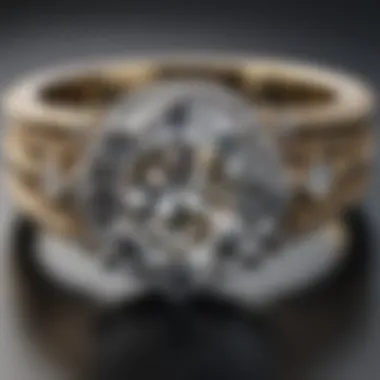
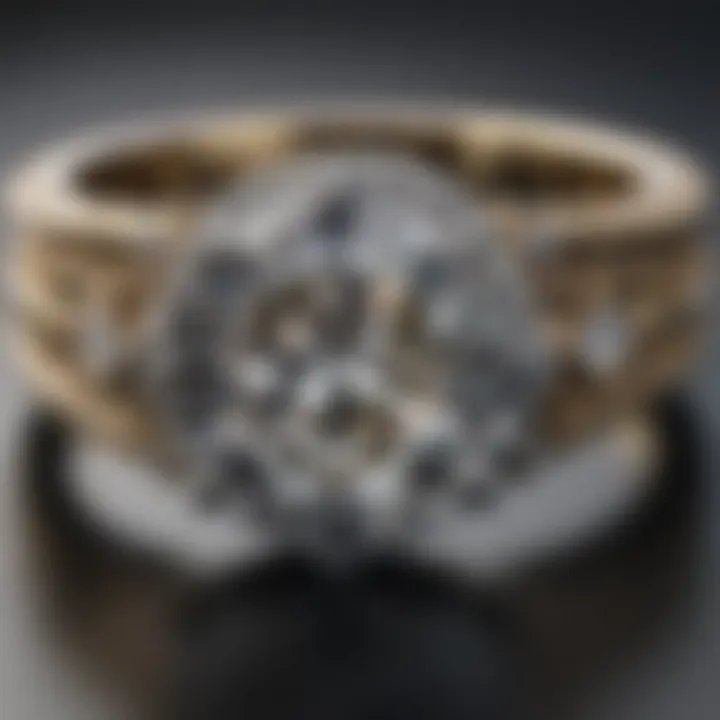
Intro
Selling old diamond rings can be both an emotional and financial decision. These pieces of jewelry carry unique personal stories and significant monetary value, making the process sensitive. The diamond market presents various alternatives for sellers, each with its own pros and cons. Understanding these can lead to a favorable outcome.
The decision to sell an old diamond ring requires careful consideration. In this article, we explore various avenues for selling old diamond rings, highlighting methods such as traditional jewelry stores, online platforms, and private auctions. Sellers will also learn how to assess their rings' value, engage with potential buyers, and conduct transactions securely.
The goal is to empower sellers through knowledge, enabling them to navigate a complex market. As we delve into the details of selling diamond rings, readers will gain insights that can assist in making informed choices.
Gemstone Overview
Definition of Gemstones
Gemstones are naturally occurring crystals or minerals that have been cut and polished for aesthetic and ornamental purposes. They are valued for their beauty, rarity, and durability. Diamonds, specifically, are among the most celebrated gemstones due to their brilliance and associated symbolism of love and commitment.
Classification of Gemstones
Gemstones can be classified into two main categories: precious and semi-precious.
- Precious Gemstones: This group includes diamonds, rubies, sapphires, and emeralds. These stones are highly sought after due to their rarity and exceptional qualities.
- Semi-Precious Gemstones: This broader category encompasses a variety of gemstones such as amethyst, turquoise, and garnet. While these are not as rare as precious stones, they still possess significant beauty and value.
Each gemstone's classification affects its market value, which is critical when assessing a diamond ring for sale.
Understanding the Diamond Market
Understanding the diamond market is crucial for anyone looking to sell an old diamond ring. This market is a complex interplay of supply, demand, and consumer fashion trends. Knowledge of market dynamics can significantly influence how much one can expect to sell their diamond for, which is essential for getting the best return on investment.
The diamond market is influenced by several factors, including the ring's characteristics, current buyer preferences, and broader economic conditions. These elements must be taken into account when determining the most effective selling strategy.
The Value of Diamonds
The value of diamonds is determined by several key factors, often referred to as the 4 Cs: carat weight, cut, color, and clarity. Each of these elements contributes to the overall worth of the diamond and can affect buyer interest.
- Carat Weight: This refers to the size of the diamond. Generally, larger diamonds are more valuable, but this can also depend on other factors.
- Cut: This impacts how well the diamond reflects light. A well-cut diamond will exhibit greater sparkle, making it more desirable.
- Color: Diamonds range in color, and those with less color (closer to colorless) are usually more sought after.
- Clarity: This refers to the presence of inclusions or blemishes. Higher clarity means fewer imperfections and a higher market value.
Understanding these factors can help sellers accurately assess their diamond's worth. In addition to the 4 Cs, other elements such as the brand of the ring, any unique features, and the current market demand can further influence value.
Market Trends
Market trends play a significant role in how diamonds are perceived and priced. Being aware of current trends can help sellers time their sale for maximum profit. Some recent trends include:
- Sustainability: There is a growing market for ethically sourced and vintage diamonds. Consumers are increasingly interested in the origins of their jewelry.
- Vintage and Antique Styles: Fashion cycles influence demand. Currently, there is a push for unique and re-purposed vintage rings, often leading to higher prices.
- Technology Impact: Laboratory-grown diamonds have become more prominent. While they are usually less expensive than natural diamonds, they are also influencing the natural diamond market.
Overall, understanding these trends allows sellers not only to gauge their ring's value more accurately but also to adjust their selling strategy accordingly. This market awareness can be a significant advantage during the selling process.
"Knowledge of the diamond market can be the difference between a low offer and a fair price."
Evaluating Your Diamond Ring
Understanding the nuances of your diamond ring is a critical step in the selling process. A thorough evaluation not only provides insight into the ring's monetary value but also enables you to engage effectively with potential buyers. Sellers who are well-informed about the specifics of their diamond possess a significant advantage. This knowledge helps in setting realistic price expectations and recognizing genuine offers.
Gemological Assessment
A gemological assessment is a professional evaluation executed by certified gemologists. They examine various aspects of a diamond, including clarity, color, carat weight, and cut. These factors collectively influence the ring's overall quality and value.
- Clarity: Refers to the presence of impurities or inclusions within the diamond. Higher clarity generally translates to greater value.
- Color: Diamonds range from colorless to shades of yellow or brown. Colorless diamonds are the most sought after.
- Carat Weight: This measures the size of the diamond, with higher carat weights typically yielding higher prices.
- Cut: The quality of the diamond's cut affects its brilliance and overall appearance.
Each of these elements is graded on a standardized scale, providing a clear framework for assessment. Having a gemological report from a reputable institution such as the Gemological Institute of America (GIA) can enhance trust and credibility during a sale. Buyers are often more inclined to make a purchase if they see certified documentation supporting the diamond's quality.
Documentation and Appraisal


Accurate documentation is crucial when selling a diamond ring. This includes any certificates and appraisals that outline the characteristics and value of the diamond.
- Certificates: Certificates from recognized institutions serve as an official verification of the diamond's specifications. Having these documents readily available can significantly bolster the perceived value of the ring.
- Appraisals: An appraisal estimates the current market value of the ring. This can help in setting a fair price when listing the ring for sale. It's advisable to obtain an appraisal conducted within the last few years to reflect current market conditions accurately.
A well-documented diamond ring not only aids in the selling process but also reassures potential buyers of their investment. As a seller, you should keep all relevant paperwork organized and accessible. This preparedness can lead to smoother negotiations and a more favorable sale outcome.
"A diamond's worth is not merely its carat; it's also about the journey it undertook and the story it holds."
In summary, evaluating your diamond ring through a gemological assessment and maintaining proper documentation enhances your selling experience. Knowledge about your diamond is power; it helps you navigate the market with confidence.
Selling Options for Old Diamond Rings
Selling options for old diamond rings play a crucial role in the overall decision-making process for diamond ring owners. Understanding the different avenues available can lead to better evaluations, higher offers, and ultimately, a more satisfying sale. This section will explore various channels through which sellers can market their diamond rings, including jewelry retailers, pawn shops, online marketplaces, auction houses, and consignment selling. Each option comes with its own set of advantages and challenges, influencing the seller's ability to reach potential buyers effectively.
Jewelry Retailers
Jewelry retailers often provide a convenient option for selling old diamond rings. These professionals have established networks and can offer immediate expertise in evaluating the item. When dealing with retailers, sellers benefit from having direct access to market trends and price standards. However, it is essential to consider that retailers might offer lower prices due to their need to resell the rings at a profit. It can be a straightforward process, requiring little more than documentation and presentation of the jewelry.
Points to consider:
- Convenience: The transaction process is often simple.
- Expert Evaluation: Retailers have experience in determining value.
- Immediate Payment: Sellers usually receive funds right away.
- Price Reduction: Expect lower offers compared to other selling methods.
Pawn Shops
Pawn shops present another option for selling old diamond rings and can be appealing for those needing quick cash. These establishments typically assess items on the spot, providing an immediate offer. However, be aware that the amount offered is likely less than its fair value. Pawn shops operate primarily through a buy-back model, meaning the seller may not fetch a strong price if they are solely looking to sell. Nevertheless, if swift access to funds is a priority, this could be a reasonable choice.
Considerations for pawn shops:
- Quick Offers: Instant assessment and payment are hallmarks of these shops.
- Lower Prices: Offers may not reflect the true market value of the diamond.
- Convenient for Emergencies: Good option if fast cash is needed.
- Possible Compromise on Value: Expect a significant cut in price.
Online Marketplaces
The rise of online marketplaces has transformed how people sell old diamond rings. Websites like eBay or Ruby Lane provide a platform where sellers can reach a wide audience. Sellers have the advantage of setting their own prices and can potentially realize higher profits. However, selling through these platforms demands careful attention to detail in listing, marketing, and managing communications with potential buyers. It's crucial to recognize that competition is fierce in this space, so an attractive presentation is essential for standing out.
Benefits of online marketplaces include:
- Vast Audience Reach: Access to millions of potential buyers.
- Higher Potential Prices: Sellers can price their items competitively.
- Flexibility: Sellers can choose the sales format – auction or fixed price.
- Time-Consuming: Requires effort in managing listings and customer inquiries.
Auction Houses
Auction houses specialized in fine jewelry serve as a notable option for selling diamond rings. These institutions leverage their reputation and established client base to attract serious buyers. Auctions can create competitive bidding situations that may drive prices higher than expected. However, it's essential to account for fees associated with auction sales, which can erode profits. This route is often ideal for high-value or unique diamond rings capable of attracting a discerning audience.
Key points of auction houses:
- Competitive Bidding: Can lead to higher sales prices.
- Reputation: Auctions maintain credibility, attracting serious buyers.
- Expert Marketing: High-quality marketing strategies can enhance visibility.
- Costs and Fees: A percentage of the sale price usually goes to the auction house.
Consignment Selling
Consignment selling provides an alternative for owners wanting to sell their diamond rings through third-party retailers. In this model, the seller provides the item to a retailer who sells it on their behalf. The seller retains a percentage from the sale price. This option can be advantageous if the seller wants to maintain a degree of control while leveraging an expert's market knowledge. However, this method may take longer, and the seller needs to trust the consignment partner.
Considerations for consignment selling:
- Retailer Support: Retailers handle marketing and staging of the ring.
- Control Over Price: Sellers can set desired price points.
- Longer Sale Period: It may take time before a sale occurs.
- Commission Fees: Sellers typically share the sale price with the retailer.
Jewelry Retailers vs. Online Marketplaces
In the intricate journey of selling old diamond rings, the choice between traditional jewelry retailers and online marketplaces is crucial. Each option carries its own set of advantages and drawbacks. Understanding these distinctions helps sellers make informed decisions that could affect not only the sale price but also the overall selling experience.
Pros of Selling in Stores
Selling to jewelry retailers has several benefits that can enhance the overall transaction process.
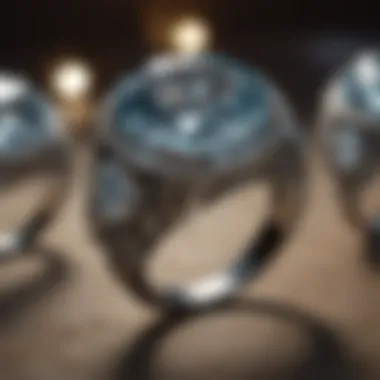
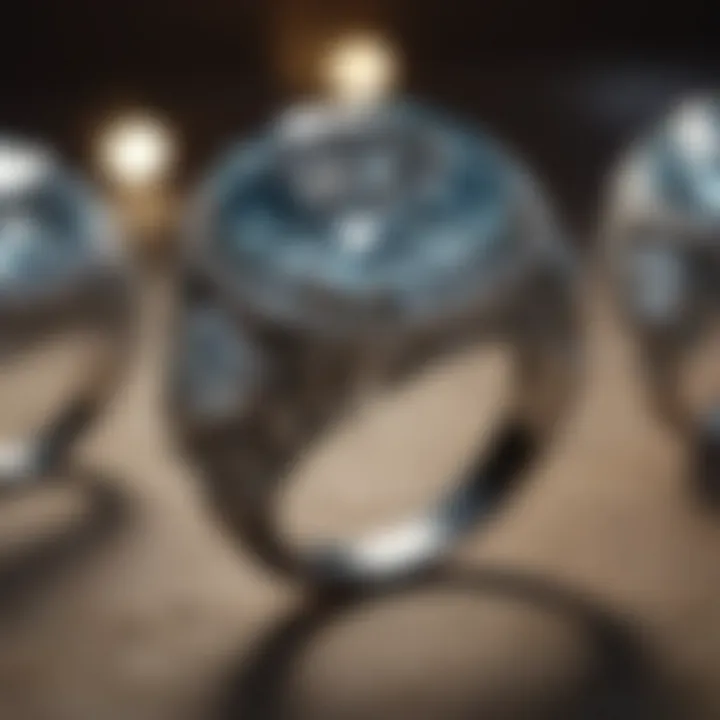
- Immediate Payment: Unlike online platforms, where waiting for buyer responses may linger, retailers typically offer instant payment upon sale agreement.
- Personal Interaction: This avenue allows for face-to-face engagement. Sellers can ask questions and negotiate directly, which presents an opportunity to establish trust.
- Expert Valuation: Retailers often have gemologists or experienced appraisers on staff. Their expertise can provide sellers with insights into the true value of the ring.
- Secure Environment: Transactions occur in a controlled and safe setting, minimizing risks associated with meeting strangers.
Cons of Store Sales
While selling in stores provides certain advantages, it also has downfalls that potential sellers must consider.
- Lower Offers: Retailers need to make a profit, which may result in lower offers for the sellers compared to what they might achieve online.
- Limited Audience: A single store's clientele may be smaller compared to the vast audience available on online platforms. This means sellers might miss out on higher offers from a broader pool of buyers.
- Less Flexibility: Most jewelry retailers have fixed pricing structures, limiting negotiation possibilities and the potential for favorable terms.
Advantages of Online Platforms
Online marketplaces, such as eBay or Etsy, have transformed how people sell diamond rings. Here are some advantages:
- Wider Reach: Online platforms can reach a global audience, significantly enhancing the possibility of finding the right buyer and potentially fetching a better price.
- Competitive Pricing: Sellers can set their price, and with the right marketing, they may attract high bids or offers that exceed those typical of retailers.
- Convenience: The process can often be completed from the comfort of one’s home. Sellers can list their rings at any time, without needing to travel to a physical location.
- Variety of Listings: Online selling allows for diverse formats, including auctions and fixed-price listings, offering great flexibility in how sellers approach potential buyers.
Risks of Online Selling
Despite the advantages, selling online also presents unique challenges.
- Trust Issues: Engaging with strangers may lead to concern about buyer reliability. Instances of fraud can occur, impacting both safety and financial return.
- Shipping and Handling: Trusting a buyer to handle the diamond with care during shipping brings an element of risk. Damage during transit can lead to significant loss.
- Platform Fees: Many online marketplaces charge various fees to list items, take a percentage of sales, or both. These can lower the overall profit from the sale.
- Inconsistent Market: The online diamond market can be unpredictable, with fluctuating demand affecting sale speed and price.
"Choosing the right platform can significantly influence both the selling price and ease of transaction when parting with an old diamond ring."
Preparing for a Sale
When it comes to selling old diamond rings, preparation is crucial. This stage can significantly influence the likelihood of a successful transaction and the overall profit realized from the sale. Sellers should take time to evaluate the key elements that contribute to the effective presentation of their diamond rings.
Cleaning and Presentation
Cleaning your diamond ring is an essential first step. A well-maintained ring enhances its visual appeal, which can attract potential buyers. To clean a diamond ring, use a mixture of warm water and mild soap. Soak the ring for about 20 to 30 minutes, then gently scrub it with a soft brush to remove any dirt or grime. This process can make the stone shine, showcasing its true brilliance. A clean ring allows buyers to see the quality of the diamond without distractions.
In addition to cleanliness, presentation plays an important role. When showcasing the ring, consider utilizing a beautiful display box or a simple cloth. This gives an impression of care and pride in ownership. Take good photographs that show the ring from different angles and in various light conditions. Ensure the lighting is adequate, as natural light often brings out the best in diamonds.
Setting a Realistic Price
Determining an appropriate price for your diamond ring is both an art and a science. Overpricing can deter potential buyers, while underpricing might lead to a financial loss. Research is needed here. Examine similar rings on platforms such as eBay, Craigslist, or specialized jewelry selling websites. Gather information regarding their prices, and take notes of factors such as size, clarity, and cut.
In addition to comparing prices, consider obtaining a professional appraisal or consultation. This provides insight into the value of your specific diamond ring. Factors like the condition of the ring, the current demand for similar diamonds, and notable market trends can also influence pricing. By setting a fair price, you increase the likelihood of a swift and satisfactory sale.
"A well-prepared seller creates a smoother transaction, helping both parties feel more confident in the sale."
Ultimately, taking the time to properly prepare can make all the difference. It equips you with the tools necessary to maximize your return while expediting the sale process effectively.
Crafting a Strong Listing
Crafting a strong listing is critical when selling old diamond rings. An effective listing attracts potential buyers and communicates the value of your ring clearly. The goal is not just to sell, but to ensure a swift and satisfactory transaction. A strong listing should differentiate your diamond ring from others on the market. It requires understanding the specific characteristics of your ring, which is essential for garnering interest.
Several elements are vital in creating a compelling listing. First, clarity is paramount. Ensure that all details about the diamond ring are accurate and presented in an easily digestible format. Details include the carat weight, cut, clarity, and color. Highlight any unique features or certifications as they enhance the ring's appeal.
In addition, adding multiple photographs showcasing the ring from various angles is important. Images should be high quality, as they significantly influence buyer decisions. Potential buyers will appreciate a comprehensive look at the item they consider purchasing.
Quickly addressing common buyer questions in your listing can streamline the selling process. Discussing the ring’s history and any previous evaluations can build trust. A detailed yet concise listing can lead to a higher likelihood of successful offers.
Key Information to Include
Include critical information that can sway a buyer's decision when creating your listing. Here are some key points:
- Carat Weight: Specify the total carat weight of the diamond.
- Cut: Describe the cut quality (e.g., excellent, very good).
- Clarity: Provide clarity grading; potential buyers want to know about imperfections.
- Color: State the diamond's color grade, as this affects value.
- Certificate: Mention if there is a grading report from organizations like the GIA (Gemological Institute of America).
- Setting: Describe the metal and style of the setting as these contribute to desirability.
- History and Condition: Discuss any repairs or age-related aspects that hold relevance for collectors.
- Price: Clearly communicate your asking price or a range. This provides serious buyers with guidance and sets expectations.
By including this information, you can present a comprehensive overview that may significantly influence buyer interest.
Photographing Your Diamond Ring
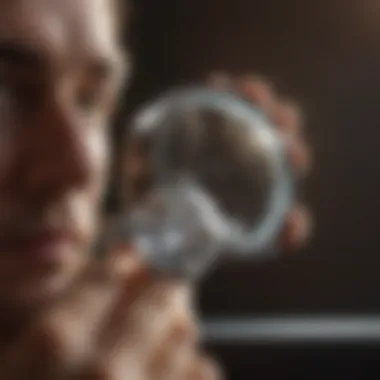

Photographs are a fundamental part of effective online listings for diamond rings. A buyer cannot physically examine the ring, so images serve as their primary means of assessment. Therefore, quality and presentation of photos cannot be overlooked.
Consider the following tips for photographing your diamond ring:
- Lighting: Use natural light for the best results. Avoid harsh shadows but ensure the diamond sparkles.
- Background: Choose a neutral, uncluttered background. A plain white or black cloth can provide a suitable setting that emphasizes the ring.
- Angles: Include multiple angles. Top-down shots, side views, and close-ups can help buyers get a better sense of the diamond’s features.
- Focus: Ensure your photos are sharp and in focus. Blurry images can diminish interest.
- Contextual Shots: Adding a hand model can enhance visualization, showing scale and aesthetics.
"Photographing plays a vital role in helping potential buyers envision the piece unequivocally."
By taking the time to create high-quality photographs, you enhance the professional appearance of your listing and potentially increase buyer inquiries.
Negotiating the Sale
Negotiating the sale of old diamond rings is a critical process that can directly influence the financial outcome of the transaction. This section outlines the factors that shape negotiations and highlights the skills necessary for securing favorable terms. Understanding the nuances of negotiations not only aids in achieving a higher selling price but also ensures that sellers engage thoughtfully with potential buyers.
Understanding Offers
Before entering negotiations, it is essential to grasp the nature of offers presented by potential buyers. An offer is typically the starting point for negotiations, representing the buyer’s perception of the ring's value. When assessing offers, consider the following elements:
- Market Research: Familiarize yourself with the current market value of similar diamond rings. This knowledge informs your expectations and helps validate whether the offer aligns with realistic pricing. Websites like en.wikipedia.org and britannica.com can provide valuable insights into diamond pricing trends.
- Buyer Motivation: Understanding the buyer’s motivations can help tailor your negotiation strategy. For instance, a buyer eyeing the ring for personal use might be more willing to negotiate than a collector who intends to resell it.
- Condition of the Ring: Mention any unique features, certifications, or appraisals that confirm the ring's value. Highlighting these points can help justify your asking price.
- Overall Market Conditions: Economic factors often affect buyers’ willingness to pay. If the diamond market is experiencing demand fluctuations, this may be reflected in their offers.
In principle, consider every offer as a dialogue starter rather than a final verdict.
Strategies for Counteroffers
When faced with an initial offer that doesn’t meet your expectations, crafting an effective counteroffer is pivotal. Here are some strategies to consider:
- Stay Calm: Maintain a professional demeanor during negotiations. Emotional responses can cloud judgment and potentially lead to unfavorable deals.
- State Your Case: Clearly articulate why your counteroffer is more appropriate. Reference research and similar sales as evidence to support your price.
- Be Flexible: Consider whether you can make slight concessions without undermining your own financial goals. Sometimes, small adjustments can lead to a successful resolution.
- Set a Bottom Line: Before negotiations commence, determine the minimum price you are willing to accept. This prevents the negotiations from drifting to unsatisfactory levels.
- Avoid Ultimatums: Demanding a specific price without reason can alienate buyers. Instead, propose prices logically, allowing for negotiation flow.
When you negotiate, you shape not only the sale but also the buyer's perception of the diamond's worth and your professionalism in the transaction.
Having a thoughtful approach to both understanding offers and crafting counteroffers enhances your chances of completing a profitable sale while fostering constructive relationships with potential buyers.
Post-Sale Considerations
After successfully selling an old diamond ring, there are several post-sale considerations that one must keep in mind. These factors are crucial as they can affect the seller's peace of mind and safety. It is advisable to approach the post-sale process with as much diligence as the sale itself.
Transfer of Ownership
Transferring ownership of the ring is not just a formality; it has legal implications. Upon completing the sale, ensure that you provide proper documentation indicating that ownership has changed hands. This document should include the purchaser's details, the transaction date, and a description of the diamond ring.
Furthermore, verify that the buyer understands the terms of ownership. For instance, if the ring had been under any warranty or guarantee, inform the new owner accordingly. Keeping open lines of communication is beneficial. Sometimes, buyers may contact sellers with queries about the ring or its care. While it is not mandatory to stay in touch, a good relationship can prevent misunderstandings in the future.
Tax Implications
Selling a diamond ring can have tax implications that vary by location and the individual's financial situation. In many regions, profits from selling personal items may be subjected to capital gains tax. Therefore, it is wise to keep accurate records of the purchase price and selling price of the ring. This documentation is key for determining any potential tax liabilities.
If the ring is sold at a loss, it may be beneficial to consult with a tax professional to understand how this might affect your tax filings. Different states or countries might have their own rules regarding how personal property sales are taxed.
In summary, understanding the post-sale elements can ensure a smooth transition for both seller and buyer. Seller’s responsibility doesn’t end with the transaction; awareness of both transfer and tax considerations can provide a clearer path forward.
The End
Selling old diamond rings can be a significant venture, often intertwined with sentiments and personal histories. Thus, making informed decisions is not just beneficial but essential for maximizing potential gains. In this article, we explored different channels and factors that influence the selling process.
It's crucial to focus on thorough evaluations of the diamond rings before initiating a sale. This evaluation helps sellers understand the unique characteristics of their rings, allowing them to set realistic expectations about value and market pricing. Knowledge of the diamond market, including current trends and the types of buyers, can also make a difference in achieving a favorable outcome.
The landscape of selling options is diverse, ranging from traditional jewelry retailers to the modern convenience of online marketplaces. Each method carries its own set of pros and cons. For instance, selling through jewelry retailers often delivers quick transactions and professional advice, but it may offer lower payouts. On the other hand, online platforms may provide broader reach and higher potential returns yet come with risks of fraud or misrepresentation.
Understanding the importance of preparation cannot be understated. Cleaning, documenting, and presenting the rings effectively can impact the sale price significantly. Negotiating the sale involves strategic communication, and awareness of post-sale considerations, such as transfer of ownership and tax implications, is equally vital. Each of these factors contributes to a more comprehensive understanding of how to approach the sale of old diamond rings.
Lastly, the conclusion emphasizes the need for vigilance. The diamond market can be tricky, so being informed and prepared increases the chance of securing a better sale. This knowledge empowers sellers, allowing them to navigate through the complexities involved while ensuring the process is as advantageous as possible.
Final Thoughts on Selling Old Diamond Rings
When selling old diamond rings, remember that the journey is both emotional and financial. Assess your specific circumstances carefully. There is no single method that suits everyone. Each seller may have different priorities or needs.
- Timing matters. Understanding market trends may help you decide the best moment to sell.
- Every detail counts. Presenting your ring in its best light, both physically and in listings, directly correlates with buyer interest.
- Anticipate negotiations. Be prepared for negotiations and don't shy away from counteroffers if you believe your ring is worth more.



